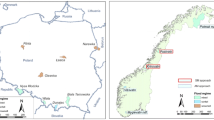Abstract
In the companion paper, Seidou et al. (2011, submitted) have shown that when adequate meteorological data are available to calibrate rainfall-runoff models, using a non-stationary GEV model with the simulated flows can provide a better description of flood peaks distributions than directly using the simulated peaks. Their methodology is extended in this paper to improve future flood peaks simulation under a changing climate. In this case, the rainfall-runoff model is forced with the downscaled outputs of the Canadian General Circulation Model CGCM3. Special attention is paid to the statistical downscaling of precipitations, as the choice of the transfer function has a significant influence on the performance of non-stationary GEV model. Stepwise regression was initially used to describe precipitation occurrence and intensity, but the patterns of the simulated hydrographs were found to be unsatisfactory. After precipitation occurrence model was successfully replaced with an ensemble of regression trees, the non-stationary GEV model was shown to provide a better description of flood peaks in the observation period. The non-stationary GEV model shows that exceedance probabilities on the Kemptville Creek will gradually rise up to 34% above current levels in 2100 for a 20-year service life.





Similar content being viewed by others
References
Boyer C, Chaumond D, Chartier I, Roy A (2010) Impact of climate change on the hydrology of St. Lawrence tributaries. J Hydrol 384(1–2):65–83
Cheng S, Auld H, Li G, Klaassen J, Li Q (2007) Possible impacts of climate change on freezing rain in south-central Canada using downscaled future climate scenarios. Nat Hazards Earth Sci Syst 7(1):71–87
Coulibaly P, Dibike YB, Anctil F (2005) Downscaling precipitation and temperature with temporal neural networks. J Hydrometeorol 6(4):483–496
DAI CGCM3 Predictors (2008) Sets of predictor variables derived from CGCM3 T47 and NCEP/NCAR Reanalysis, version 1.1, November 2009, Montreal, QC, Canada, (http://loki.qc.ec.gc.ca/DAI/doc/technique/DAI_Predictors_CGCM3andNCEP_January2010_EN.pdf)
Dibike YB, Coulibaly P (2006) Temporal neural networks for downscaling climate variability and extremes. Special Issue Neural Netw 19(2):135–144
Giorgi F, Hewitson B, Christensen J, Fu C, Jones R, Hulme M, Mearns L, Von Storch H, Whetton P (2001) Regional climate information evaluation and projections. In: Houghton JT et al (eds) Climate change 2001: the scientific basis. Cambridge University Press, Cambridge, p 944
Hessami M, Gachon P, Ouarda T, St-Hilaire A (2008) Automated regression-based statistical downscaling tool. Environ Model Softw 23:813–834
Kharin VV, Zwiers FW (2005) Estimating extremes in transient climate change simulations. J Clim 18(8):1156–1173
Mearns LO, Rosenzweig C, Goldberg R (1997) Mean and variance change in climate scenarios: Methods, agricultural applications, and measures of uncertainty. Clim Change 35:367–396
Seidou O, Ramsay A, Nistor I (2011) Climate change impacts on extreme floods: combining of imperfect deterministic simulations and non-stationary frequency analysis. Submitted
Wang Jiafeng, Zhang Xuebin (2008) Downscaling and projection of winter extreme daily precipitation over North America. J Clim 21:923–937
Wilby RL, Dawson CW, Barrow EM (2002) SDSM: a decision support tool for the assessment of regional climate change impacts. Environ Model Softw 17:147–159
Author information
Authors and Affiliations
Corresponding author
Rights and permissions
About this article
Cite this article
Seidou, O., Ramsay, A. & Nistor, I. Climate change impacts on extreme floods II: improving flood future peaks simulation using non-stationary frequency analysis. Nat Hazards 60, 715–726 (2012). https://doi.org/10.1007/s11069-011-0047-7
Received:
Accepted:
Published:
Issue Date:
DOI: https://doi.org/10.1007/s11069-011-0047-7




